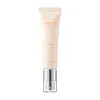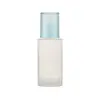What's inside
What's inside
 Key Ingredients
Key Ingredients

 Benefits
Benefits

 Concerns
Concerns

 Ingredients Side-by-side
Ingredients Side-by-side

Water
Skin ConditioningZinc Oxide
Cosmetic ColorantCyclohexasiloxane
EmollientButyloctyl Salicylate
Skin ConditioningPropanediol
SolventPropylheptyl Caprylate
EmollientTitanium Dioxide
Cosmetic ColorantCaprylyl Methicone
Skin ConditioningPolyglyceryl-4 Diisostearate/Polyhydroxystearate/Sebacate
EmulsifyingMethyl Methacrylate Crosspolymer
Niacinamide
SmoothingMethyl Trimethicone
Skin ConditioningTrimethylsiloxysilicate
EmollientPrunus Persica Flower Extract
MoisturisingSodium Hyaluronate
HumectantTocopherol
AntioxidantButylene Glycol
HumectantDimethylsilanol Hyaluronate
HumectantSodium Acetylated Hyaluronate
HumectantSodium Hyaluronate Dimethylsilanol
HumectantSodium Hyaluronate Crosspolymer
HumectantPotassium Hyaluronate
Skin ConditioningHydroxypropyltrimonium Hyaluronate
Hydrolyzed Sodium Hyaluronate
Skin ConditioningHydrolyzed Hyaluronic Acid
HumectantHyaluronic Acid
HumectantDisteardimonium Hectorite
StabilisingMagnesium Sulfate
Triethoxycaprylylsilane
Polyglyceryl-2 Dipolyhydroxystearate
Skin ConditioningPolymethylsilsesquioxane
Lauryl Polyglyceryl-3 Polydimethylsiloxyethyl Dimethicone
Skin ConditioningDicaprylyl Carbonate
EmollientGlyceryl Caprylate
EmollientCaprylyl Glycol
EmollientMica
Cosmetic Colorant1,2-Hexanediol
Skin ConditioningEthylhexylglycerin
Skin ConditioningAdenosine
Skin ConditioningParfum
MaskingCI 77492
Cosmetic ColorantCI 77491
Cosmetic ColorantCI 77499
Cosmetic ColorantWater, Zinc Oxide, Cyclohexasiloxane, Butyloctyl Salicylate, Propanediol, Propylheptyl Caprylate, Titanium Dioxide, Caprylyl Methicone, Polyglyceryl-4 Diisostearate/Polyhydroxystearate/Sebacate, Methyl Methacrylate Crosspolymer, Niacinamide, Methyl Trimethicone, Trimethylsiloxysilicate, Prunus Persica Flower Extract, Sodium Hyaluronate, Tocopherol, Butylene Glycol, Dimethylsilanol Hyaluronate, Sodium Acetylated Hyaluronate, Sodium Hyaluronate Dimethylsilanol, Sodium Hyaluronate Crosspolymer, Potassium Hyaluronate, Hydroxypropyltrimonium Hyaluronate, Hydrolyzed Sodium Hyaluronate, Hydrolyzed Hyaluronic Acid, Hyaluronic Acid, Disteardimonium Hectorite, Magnesium Sulfate, Triethoxycaprylylsilane, Polyglyceryl-2 Dipolyhydroxystearate, Polymethylsilsesquioxane, Lauryl Polyglyceryl-3 Polydimethylsiloxyethyl Dimethicone, Dicaprylyl Carbonate, Glyceryl Caprylate, Caprylyl Glycol, Mica, 1,2-Hexanediol, Ethylhexylglycerin, Adenosine, Parfum, CI 77492, CI 77491, CI 77499
Cyclopentasiloxane
EmollientWater
Skin ConditioningHdi/Trimethylol Hexyllactone Crosspolymer
Isododecane
EmollientDimethicone
EmollientPEG-10 Dimethicone
Skin ConditioningDimethicone Crosspolymer
Emulsion StabilisingButylene Glycol
HumectantVinyl Dimethicone/Methicone Silsesquioxane Crosspolymer
Glycerin
HumectantDimethicone/Vinyl Dimethicone Crosspolymer
Skin ConditioningPanthenol
Skin ConditioningNymphaea Caerulea Flower Water
Skin Conditioning1,2-Hexanediol
Skin ConditioningDisteardimonium Hectorite
StabilisingMagnesium Sulfate
Sorbitan Sesquiisostearate
EmulsifyingBeeswax
Emulsion StabilisingSilica
AbrasivePalmitic Acid
EmollientStearic Acid
CleansingPhloretin
AntioxidantSilica Silylate
EmollientAlcohol Denat.
AntimicrobialBakuchiol
AntimicrobialCI 77220
Cosmetic ColorantAsiaticoside
AntioxidantMadecassic Acid
Skin ConditioningAsiatic Acid
Skin ConditioningCitrus Unshiu Peel Extract
MaskingParfum
MaskingBenzyl Benzoate
AntimicrobialBenzyl Salicylate
PerfumingLinalool
PerfumingAlpha-Isomethyl Ionone
PerfumingGeraniol
PerfumingLimonene
PerfumingHydroxycitronellal
PerfumingCoumarin
PerfumingCyclopentasiloxane, Water, Hdi/Trimethylol Hexyllactone Crosspolymer, Isododecane, Dimethicone, PEG-10 Dimethicone, Dimethicone Crosspolymer, Butylene Glycol, Vinyl Dimethicone/Methicone Silsesquioxane Crosspolymer, Glycerin, Dimethicone/Vinyl Dimethicone Crosspolymer, Panthenol, Nymphaea Caerulea Flower Water, 1,2-Hexanediol, Disteardimonium Hectorite, Magnesium Sulfate, Sorbitan Sesquiisostearate, Beeswax, Silica, Palmitic Acid, Stearic Acid, Phloretin, Silica Silylate, Alcohol Denat., Bakuchiol, CI 77220, Asiaticoside, Madecassic Acid, Asiatic Acid, Citrus Unshiu Peel Extract, Parfum, Benzyl Benzoate, Benzyl Salicylate, Linalool, Alpha-Isomethyl Ionone, Geraniol, Limonene, Hydroxycitronellal, Coumarin
Ingredients Explained
These ingredients are found in both products.
Ingredients higher up in an ingredient list are typically present in a larger amount.
1,2-Hexanediol is a synthetic liquid and another multi-functional powerhouse.
It is a:
- Humectant, drawing moisture into the skin
- Emollient, helping to soften skin
- Solvent, dispersing and stabilizing formulas
- Preservative booster, enhancing the antimicrobial activity of other preservatives
Butylene Glycol (or BG) is used within cosmetic products for a few different reasons:
Overall, Butylene Glycol is a safe and well-rounded ingredient that works well with other ingredients.
Though this ingredient works well with most skin types, some people with sensitive skin may experience a reaction such as allergic rashes, closed comedones, or itchiness.
Learn more about Butylene GlycolDisteardimonium Hectorite comes from the clay mineral named hectorite. It is used to add thickness to a product.
It can also help stabilize a product by helping to disperse other ingredients.
Hectorite is a rare, white clay mineral.
Learn more about Disteardimonium HectoriteMagnesium Sulfate is a salt. More specifically, it is an epsom salt, or the bath salt used to help relieve muscle aches.
Despite having ‘sulfate’ in the name, it isn’t a surfactant or cleansing agent like sodium lauryl sulfate. Unlike those sulfates, magnesium sulfate doesn’t have the same cleansing or foaming properties (it's simply a type of salt).
In cosmetics, Magnesium Sulfate is used to thicken a product or help dilute other solids. It is a non-reactive and non-irritating ingredient.
One study shows magnesium deficiency may lead to inflammation of the skin. Applying magnesium topically may help reduce inflammation.
You can find this ingredient in sea water or mineral deposits.
Learn more about Magnesium SulfateParfum is a catch-all term for an ingredient or more that is used to give a scent to products.
Also called "fragrance", this ingredient can be a blend of hundreds of chemicals or plant oils. This means every product with "fragrance" or "parfum" in the ingredients list is a different mixture.
For instance, Habanolide is a proprietary trade name for a specific aroma chemical. When used as a fragrance ingredient in cosmetics, most aroma chemicals fall under the broad labeling category of “FRAGRANCE” or “PARFUM” according to EU and US regulations.
The term 'parfum' or 'fragrance' is not regulated in many countries. In many cases, it is up to the brand to define this term.
For instance, many brands choose to label themselves as "fragrance-free" because they are not using synthetic fragrances. However, their products may still contain ingredients such as essential oils that are considered a fragrance by INCI standards.
One example is Calendula flower extract. Calendula is an essential oil that still imparts a scent or 'fragrance'.
Depending on the blend, the ingredients in the mixture can cause allergies and sensitivities on the skin. Some ingredients that are known EU allergens include linalool and citronellol.
Parfum can also be used to mask or cover an unpleasant scent.
The bottom line is: not all fragrances/parfum/ingredients are created equally. If you are worried about fragrances, we recommend taking a closer look at an ingredient. And of course, we always recommend speaking with a professional.
Learn more about ParfumWater. It's the most common cosmetic ingredient of all. You'll usually see it at the top of ingredient lists, meaning that it makes up the largest part of the product.
So why is it so popular? Water most often acts as a solvent - this means that it helps dissolve other ingredients into the formulation.
You'll also recognize water as that liquid we all need to stay alive. If you see this, drink a glass of water. Stay hydrated!
Learn more about Water